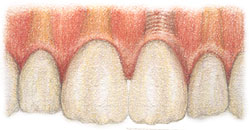Cosmetic Dentistry > Dental Implants
Dental Implants
Table of Contents
Overview
Dental Implants are the most natural
replacement for missing teethDental implants are a permanent and comfortable replacement for one or more missing teeth that are often used in place of a fixed bridge.
Traditionally, several missing teeth would be replaced with a partial or full denture. Dentures may cause discomfort, and do not stimulate the jaw bone as regular teeth do. Without stimulation, the jawbone degrades, causing a “caved-in” appearance that is often associated with age.
Dental implants replace the function and appearance of your natural teeth in a more complete manner. Titanium posts are surgically installed in the jaw bone, taking the place of the roots of your lost teeth. These posts stimulate the jawbone and strongly secure your teeth in the same way your natural tooth roots would. The surfaces of the posts are provided with one or more treatments, prior to placement in the jaw, that helps them to integrate into the bone.
A crown is fitted onto the top of the titanium post that looks and feels like a natural tooth. Crowns are made in dental laboratories by trained technicians, and are custom-designed to fit the natural shape and color of your teeth. You are able to better regain your appearance than with full dentures that are at times overly white or artificial-seeming.
Bone Grafts
In order to be a candidate for dental implants, there first must be sufficient bone material in the jaw to accept the titanium posts. In some cases, a bone graft may be a necessary first step to placing a dental implant.
A bone graft is a procedure in which your dental practitioner adds to the amount of jawbone available to accept an implant. Material for the graft can be obtained from other areas of the jawbone, other areas of the body, or from synthesized bone material. (If the bone is to be taken from other areas of the body, referral to an orthopedic surgeon is necessary).
Dental Implant Placement Procedure
There are now a wide variety of dental implant placement procedures that vary in duration and materials. Any implant procedure is preceded by a detailed consultation, in which all options for treatment should be thoroughly discussed.
Duration of the Procedure
The duration of the procedure is highly variable, largely because healing is often required in between steps of the procedure.
In some cases, when there is abundant jawbone tissue and the patient is in good health, some specialists offer “immediate loading”. In this single-day procedure, the implant and crown are placed simultaneously.
More commonly, the crown is fitted several months after implant placement, allowing the implant time to fuse with the jawbone. In cases involving bone grafting, the graft must first heal for several months before the implant can be installed. Then the implant must integrate into the bone for several months before the crown can be adhered to the implant.
Types of Implants
Root Form Implant
The first and most commonly installed dental implant is called a “root form implant”. Root form implants are grooved like screws, but otherwise are similar in size and shape to a natural tooth root. These implants are used when there is sufficient depth and width to the area of the jaw to accept the fixture.Plate Form Implant
Plate form implants are just as you might imagine them- they are relatively long and flat. Plate form implants are used on patients with narrow jaws that may not properly support the wider root form implants.Subperiosteal Implant
Subperiosteal implants are custom fitted to sit atop the jaw, in cases where the bone is too short or narrow to accept plate or root form implants. Your specialist will determine the appropriate shape of the implant either by taking an impression of the jawbone, which requires a preliminary surgical procedure, or by taking a CAT scan of the jaw and creating an impression from the three-dimensional model.General Implant Placement Procedure
While there is some variation in procedure, the following outlines the basic steps required for dental implant placement.
First, a general anesthetic is administered. Then the gum covering the area is gently folded back and the underlying bone prepared to receive the implant. The extent of the bone preparation is dependent on the number of implants required. The jaw is treated with a cooling material to maintain its stability during the implant placement. The implant(s) are then installed, and the gum sutured. The implant should fully integrate into the bone after 3 to 6 months.
At this point or at the time of implant placement, in the case of immediate loading, a custom-designed crown is fitted over the post. The details of the procedure change slightly with the structure of the implant used.
Life Span of Dental Implants
The titanium implant itself is amazingly sturdy and should last a lifetime. The crown covering it lasts on average 10 years, but with conscientious care can last up to 30 years.
Cost of Dental Implant Procedures
Dental implants are costly in relation to other restoratives. A basic dental implant procedure for one missing tooth typically costs between $1,250 and $4,000, depending on the materials, number of visits required and complexity of the case. Full mouth reconstructions usually start at about $12,000 per arch. Bone grafting procedures may add to this cost.
The benefits to you are that your treatment plan is carefully constructed by a highly-trained dental specialist (prosthodontist) and will last a lifetime, saving you on years of discomfort and money spent on maintaining less ideal restorations.
For more information on dental implants, visit dentalimplants.org


